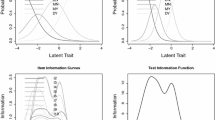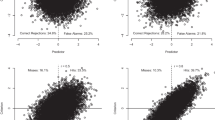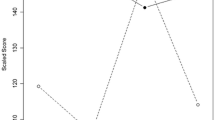Abstract
An unresolved issue in student evaluations of teaching effectiveness (SETE) literature is what type of overall evaluation of teaching effectiveness should be used in personnel decisions. The objective of this study is to compare the merits of: (a) an overall evaluation made by students, (b) a weighted average overall evaluation with the weights determined by students, (c) a weighted average overall evaluation with the weights being determined by the individual instructors teaching their respective classes, (d) an unweighted average overall evaluation, and (e) a second-order factor that proxies for an overall evaluation. Our results indicate that: (a) all of these overall evaluations were very highly intercorrelated, (b) the unweighted and weighted average overall evaluations measured virtually the same thing, and (c) the second-order factor that served as an overall evaluation was most highly correlated with the other overall evaluations and had the advantage of being most understandable to the faculty.
Similar content being viewed by others
REFERENCES
Abrami, P. C. (1985). Dimensions of effective college instruction. Review of Higher Education 8(3): 211-228.
Abrami, P. C. (1989). How should we use student ratings to evaluate teaching? Research in Higher Education 30: 221-227.
Abrami, P. C., and d'Apollonia, S. (1990). The dimensionality of ratings and their use in personnel decisions. In: Theall, M., and Franklin, J. (eds), New Directions for Teaching and Learning Student Ratings of Instruction: Issues for Improving Practice (No. 43), Jossey-Bass, San Francisco, pp. 97-111.
Abrami, P. C., and d'Apollonia, S. (1991). Multidimensional students' evaluations of teaching effectiveness-generalizability of “N = 1” research: Comment on Marsh (1991). Journal of Educational Psychology 83(3): 411-415.
Abrami, P. C., and d'Apollonia, S. (1999). Current concerns are past concerns. American Psychologist 54(7): 519-520.
Burdsal, C. A., and Bardo, J. W. (1986). Measuring student's perceptions of teaching: Dimensions of evaluation. Educational and Psychological Measurement 46: 63-79.
Cashin, W. E., and Downey, R. G. (1992). Using global student rating items for summative evaluation. Journal of Educational Psychology 84(4): 563-572.
d'Apollonia, S. and Abrami, P. C. (1997). Navigating student ratings of instruction. Journal of Educational Psychology 52(11): 1198-1208.
Feldman, K. A. (1988). Effective college teaching from the students' and faculty view: Matched or mismatched priorities? Research in Higher Education 28: 291-344.
Frey, P. W. (1973). Student ratings of teaching: Validity of several rating factors. Science 182: 83-85.
Frey, P. W. (1974, February). The ongoing debate: Student evaluation of teaching. Change 6(1): 47-49.
Frey, P. W. (1978). A two-dimensional analysis of student ratings of instruction. Research in Higher Education 9: 69-91.
Gillmore, G. M., and Greenwald, A. G., (1999). Using statistical adjustment to reduce bias in student ratings. American Psychologist 54(7): 518-519.
Greenwald, A. G. (1997). Validity concerns and usefulness of student ratings of instruction. Journal of Educational Psychology 52(11): 1182-1186.
Greenwald, A. G., and Gillmore, G. M. (1997). Grading leniency is a removable contaminant of student ratings. Journal of Educational Psychology 52(11): 1209-1217.
Harrison, P. D., Ryan, J. M., and Moore, P.S. (1996). College students' self-insight and common implicit theories in ratings of teaching effectiveness. Journal of Educational Psychology 88(4): 775-782.
L'Hommedieu, R., Menges, R. J., and Brinko, K. T. (1990). Methodological explanations for the modest effects of feedback. Journal of Educational Psychology 82: 232-241.
Jackson, D. L., Teal, C. R., Raines, S. J., Nansel, T. R., Force, R. C., and Burdsal, C. A. (1999). The dimensions of students' perceptions of teaching effectiveness. Educational and Psychological Measurement 59(4): 580-596.
Marsh, H. W. (1977). The validity of students' evaluations: Classroom evaluations of instructors independently nominated as best and worst teachers by graduating seniors. American Educational Research Journal 14(4): 441-447.
Marsh, H. W. (1982). SEEQ: A reliable, valid, and useful instrument for collecting students' evaluations of university teaching. British Journal of Educational Psychology 52(1): 77-95.
Marsh, H. W. (1983). Multidimensional ratings of teaching effectiveness by students for different academic settings and their relationship to student/course/instructor characteristics. Journal of Educational Psychology 75(1): 150-166.
Marsh, H. W. (1984). Students' evaluations of university teaching dimensionality, reliability, validity, potential biases, and utility. Journal of Educational Psychology 76(5): 707-754.
Marsh, H. W. (1986). Global self-esteem: Its relation to specific facets of self-concept and their importance. Journal of Personality and Social Psychology 51: 1224-1236.
Marsh, H. W. (1991). A multidimensional perspective on students' evaluations of teaching effectiveness: A reply to Abrami and d'Apollonia. Journal of Educational Psychology 83(3): 416-421.
Marsh, H. W. (1994). Weighting for the right criteria to validate student evaluations of teaching in the IDEA system. Journal of Educational Psychology 86(4): 631-648.
Marsh, H. W., and Dunkin, M. (1992). Students' evaluations of university teaching: A multidimensional perspective. Higher Education: Handbook on Theory and Research (Vol. 8), Agathon, New York.
Marsh, H. W., Fleiner, H., and Thomas, C. S. (1975). Validity and usefulness of student evaluations of instructional quality. Journal of Educational Psychology 67(6): 833-839.
Marsh, H. W., and Hocevar, D. (1991). The multidimensionality of students' evaluations of teaching effectiveness: The generality of factor structures across academic discipline, instructor level, and course level. Teaching & Teacher Education 7(1): 9-18.
Marsh, H. W., and Overall, J. U. (1980). Validity of students' evaluations of teaching effectiveness: Cognitive and affective criteria. Journal of Educational Psychology 72: 468-475.
Marsh, H. W., Overall, J. U., and Kesler, S. P. (1979). Class size, students' evaluations, and instructional effectiveness. American Educational Research Journal 16(1): 57-70.
Marsh, H. W., and Roche, L. A. (1992). The use of student evaluations of university instructors in different settings. Australian Journal of Education 36: 278-300.
Marsh, H. W., and Roche, L. A. (1993). The use of students' evaluations and an individually structured intervention to enhance university teaching effectiveness. American Educational Research Journal 30(1): 217-251.
Marsh, H. W., and Roche, L. A. (1997). Making students' evaluations of teaching effectiveness effective: The critical issues of validity, bias, and utility. Journal of Educational Psychology 52(11): 1187-1197.
Marsh, H. W., and Roche, L. A. (1999). Rely upon SET research. American Psychologist 54(7): 517-518
McKeachie, W. J. (1997). Student ratings: The validity of use. Journal of Educational Psychology 52(11): 1218-1225.
Ryan, J. M., and Harrison, P. D. (1995). The relationship between individual instructional characteristics and the overall assessment of teaching effectiveness across different instructional contexts. Research in Higher Education 36: 213-228.
Author information
Authors and Affiliations
Corresponding author
Rights and permissions
About this article
Cite this article
Harrison, P.D., Douglas, D.K. & Burdsal, C.A. The Relative Merits of Different Types of Overall Evaluations of Teaching Effectiveness. Research in Higher Education 45, 311–323 (2004). https://doi.org/10.1023/B:RIHE.0000019592.78752.da
Issue Date:
DOI: https://doi.org/10.1023/B:RIHE.0000019592.78752.da




